Cranioplasty and Neurological Function
VerifiedAdded on 2020/06/06
|8
|2461
|62
AI Summary
This assignment delves into various aspects of brain injury management. It examines the effects of cranioplasty on neurological function, citing studies on its impact. The document also explores different methods used to monitor intracranial pressure in patients with traumatic brain injuries and acute CNS infections. This includes techniques like transcranial Doppler ultrasound, ventricular drains, and optic nerve sheath diameter measurement. Additionally, it touches upon treatments for raised intracranial pressure, including cerebral perfusion pressure-targeted therapy and comparisons between various monitoring strategies.
Contribute Materials
Your contribution can guide someone’s learning journey. Share your
documents today.

Clinical
Vignette Concept
Vignette Concept
Secure Best Marks with AI Grader
Need help grading? Try our AI Grader for instant feedback on your assignments.

TABLE OF CONTENTS
PART A...........................................................................................................................................1
PART B............................................................................................................................................2
REFERENCES................................................................................................................................5
PART A...........................................................................................................................................1
PART B............................................................................................................................................2
REFERENCES................................................................................................................................5
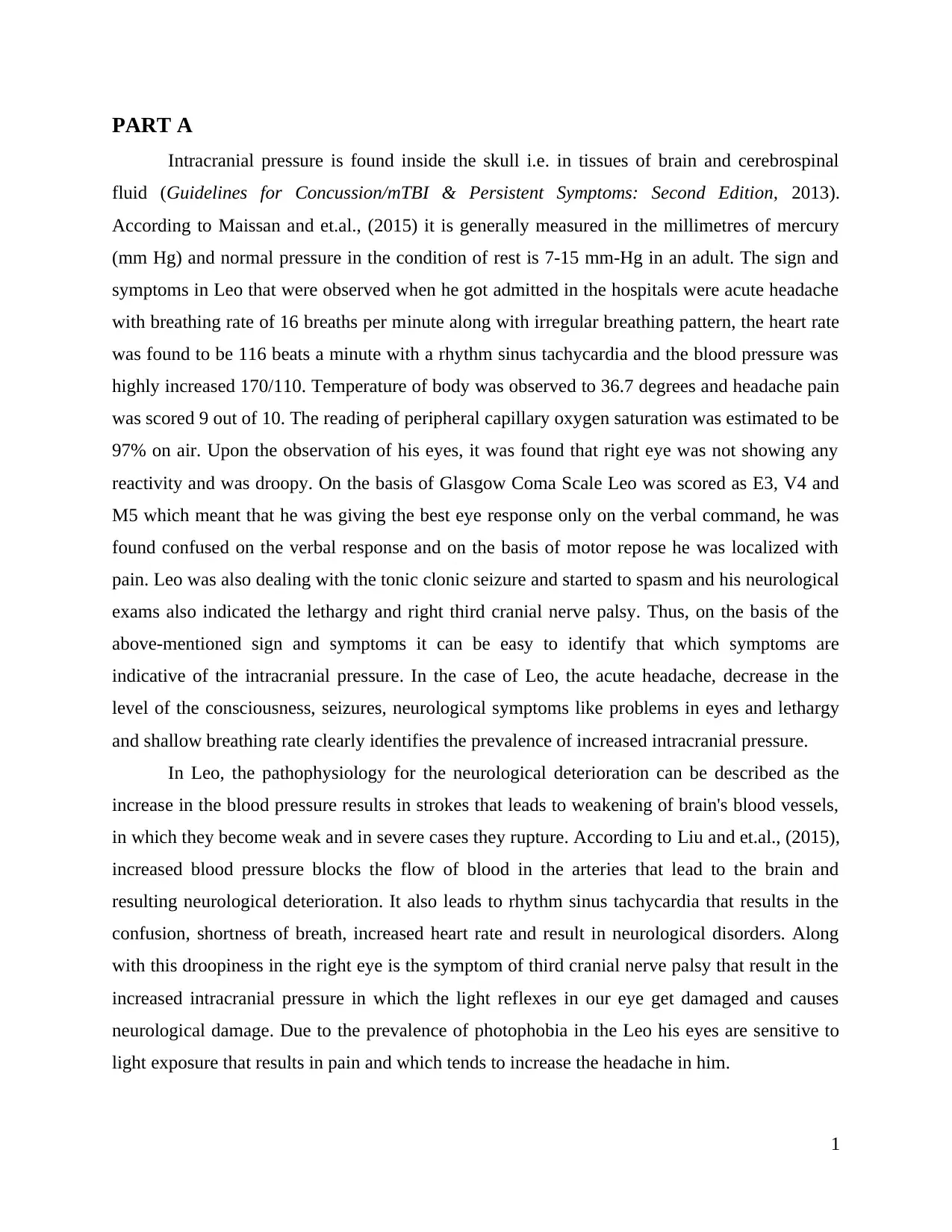
PART A
Intracranial pressure is found inside the skull i.e. in tissues of brain and cerebrospinal
fluid (Guidelines for Concussion/mTBI & Persistent Symptoms: Second Edition, 2013).
According to Maissan and et.al., (2015) it is generally measured in the millimetres of mercury
(mm Hg) and normal pressure in the condition of rest is 7-15 mm-Hg in an adult. The sign and
symptoms in Leo that were observed when he got admitted in the hospitals were acute headache
with breathing rate of 16 breaths per minute along with irregular breathing pattern, the heart rate
was found to be 116 beats a minute with a rhythm sinus tachycardia and the blood pressure was
highly increased 170/110. Temperature of body was observed to 36.7 degrees and headache pain
was scored 9 out of 10. The reading of peripheral capillary oxygen saturation was estimated to be
97% on air. Upon the observation of his eyes, it was found that right eye was not showing any
reactivity and was droopy. On the basis of Glasgow Coma Scale Leo was scored as E3, V4 and
M5 which meant that he was giving the best eye response only on the verbal command, he was
found confused on the verbal response and on the basis of motor repose he was localized with
pain. Leo was also dealing with the tonic clonic seizure and started to spasm and his neurological
exams also indicated the lethargy and right third cranial nerve palsy. Thus, on the basis of the
above-mentioned sign and symptoms it can be easy to identify that which symptoms are
indicative of the intracranial pressure. In the case of Leo, the acute headache, decrease in the
level of the consciousness, seizures, neurological symptoms like problems in eyes and lethargy
and shallow breathing rate clearly identifies the prevalence of increased intracranial pressure.
In Leo, the pathophysiology for the neurological deterioration can be described as the
increase in the blood pressure results in strokes that leads to weakening of brain's blood vessels,
in which they become weak and in severe cases they rupture. According to Liu and et.al., (2015),
increased blood pressure blocks the flow of blood in the arteries that lead to the brain and
resulting neurological deterioration. It also leads to rhythm sinus tachycardia that results in the
confusion, shortness of breath, increased heart rate and result in neurological disorders. Along
with this droopiness in the right eye is the symptom of third cranial nerve palsy that result in the
increased intracranial pressure in which the light reflexes in our eye get damaged and causes
neurological damage. Due to the prevalence of photophobia in the Leo his eyes are sensitive to
light exposure that results in pain and which tends to increase the headache in him.
1
Intracranial pressure is found inside the skull i.e. in tissues of brain and cerebrospinal
fluid (Guidelines for Concussion/mTBI & Persistent Symptoms: Second Edition, 2013).
According to Maissan and et.al., (2015) it is generally measured in the millimetres of mercury
(mm Hg) and normal pressure in the condition of rest is 7-15 mm-Hg in an adult. The sign and
symptoms in Leo that were observed when he got admitted in the hospitals were acute headache
with breathing rate of 16 breaths per minute along with irregular breathing pattern, the heart rate
was found to be 116 beats a minute with a rhythm sinus tachycardia and the blood pressure was
highly increased 170/110. Temperature of body was observed to 36.7 degrees and headache pain
was scored 9 out of 10. The reading of peripheral capillary oxygen saturation was estimated to be
97% on air. Upon the observation of his eyes, it was found that right eye was not showing any
reactivity and was droopy. On the basis of Glasgow Coma Scale Leo was scored as E3, V4 and
M5 which meant that he was giving the best eye response only on the verbal command, he was
found confused on the verbal response and on the basis of motor repose he was localized with
pain. Leo was also dealing with the tonic clonic seizure and started to spasm and his neurological
exams also indicated the lethargy and right third cranial nerve palsy. Thus, on the basis of the
above-mentioned sign and symptoms it can be easy to identify that which symptoms are
indicative of the intracranial pressure. In the case of Leo, the acute headache, decrease in the
level of the consciousness, seizures, neurological symptoms like problems in eyes and lethargy
and shallow breathing rate clearly identifies the prevalence of increased intracranial pressure.
In Leo, the pathophysiology for the neurological deterioration can be described as the
increase in the blood pressure results in strokes that leads to weakening of brain's blood vessels,
in which they become weak and in severe cases they rupture. According to Liu and et.al., (2015),
increased blood pressure blocks the flow of blood in the arteries that lead to the brain and
resulting neurological deterioration. It also leads to rhythm sinus tachycardia that results in the
confusion, shortness of breath, increased heart rate and result in neurological disorders. Along
with this droopiness in the right eye is the symptom of third cranial nerve palsy that result in the
increased intracranial pressure in which the light reflexes in our eye get damaged and causes
neurological damage. Due to the prevalence of photophobia in the Leo his eyes are sensitive to
light exposure that results in pain and which tends to increase the headache in him.
1
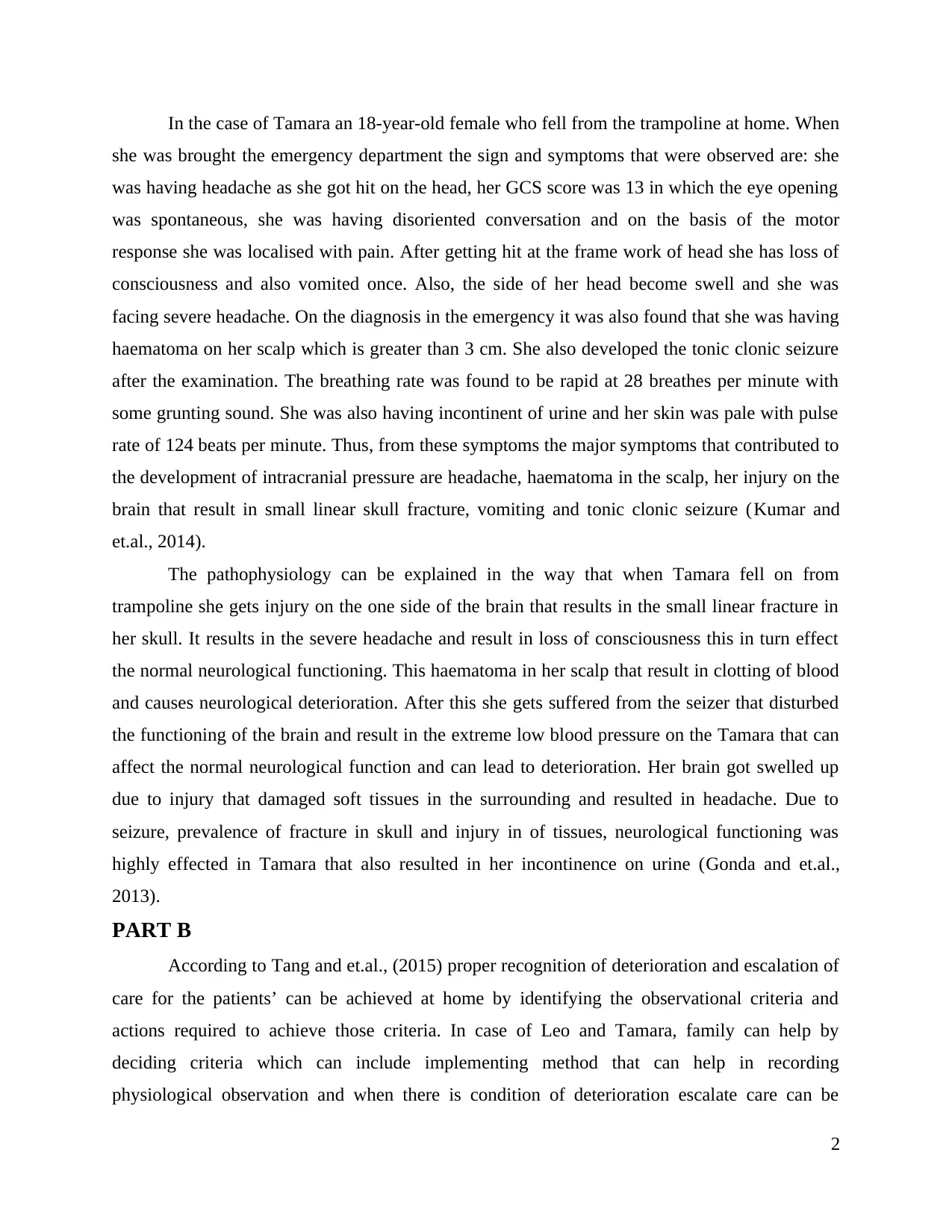
In the case of Tamara an 18-year-old female who fell from the trampoline at home. When
she was brought the emergency department the sign and symptoms that were observed are: she
was having headache as she got hit on the head, her GCS score was 13 in which the eye opening
was spontaneous, she was having disoriented conversation and on the basis of the motor
response she was localised with pain. After getting hit at the frame work of head she has loss of
consciousness and also vomited once. Also, the side of her head become swell and she was
facing severe headache. On the diagnosis in the emergency it was also found that she was having
haematoma on her scalp which is greater than 3 cm. She also developed the tonic clonic seizure
after the examination. The breathing rate was found to be rapid at 28 breathes per minute with
some grunting sound. She was also having incontinent of urine and her skin was pale with pulse
rate of 124 beats per minute. Thus, from these symptoms the major symptoms that contributed to
the development of intracranial pressure are headache, haematoma in the scalp, her injury on the
brain that result in small linear skull fracture, vomiting and tonic clonic seizure (Kumar and
et.al., 2014).
The pathophysiology can be explained in the way that when Tamara fell on from
trampoline she gets injury on the one side of the brain that results in the small linear fracture in
her skull. It results in the severe headache and result in loss of consciousness this in turn effect
the normal neurological functioning. This haematoma in her scalp that result in clotting of blood
and causes neurological deterioration. After this she gets suffered from the seizer that disturbed
the functioning of the brain and result in the extreme low blood pressure on the Tamara that can
affect the normal neurological function and can lead to deterioration. Her brain got swelled up
due to injury that damaged soft tissues in the surrounding and resulted in headache. Due to
seizure, prevalence of fracture in skull and injury in of tissues, neurological functioning was
highly effected in Tamara that also resulted in her incontinence on urine (Gonda and et.al.,
2013).
PART B
According to Tang and et.al., (2015) proper recognition of deterioration and escalation of
care for the patients’ can be achieved at home by identifying the observational criteria and
actions required to achieve those criteria. In case of Leo and Tamara, family can help by
deciding criteria which can include implementing method that can help in recording
physiological observation and when there is condition of deterioration escalate care can be
2
she was brought the emergency department the sign and symptoms that were observed are: she
was having headache as she got hit on the head, her GCS score was 13 in which the eye opening
was spontaneous, she was having disoriented conversation and on the basis of the motor
response she was localised with pain. After getting hit at the frame work of head she has loss of
consciousness and also vomited once. Also, the side of her head become swell and she was
facing severe headache. On the diagnosis in the emergency it was also found that she was having
haematoma on her scalp which is greater than 3 cm. She also developed the tonic clonic seizure
after the examination. The breathing rate was found to be rapid at 28 breathes per minute with
some grunting sound. She was also having incontinent of urine and her skin was pale with pulse
rate of 124 beats per minute. Thus, from these symptoms the major symptoms that contributed to
the development of intracranial pressure are headache, haematoma in the scalp, her injury on the
brain that result in small linear skull fracture, vomiting and tonic clonic seizure (Kumar and
et.al., 2014).
The pathophysiology can be explained in the way that when Tamara fell on from
trampoline she gets injury on the one side of the brain that results in the small linear fracture in
her skull. It results in the severe headache and result in loss of consciousness this in turn effect
the normal neurological functioning. This haematoma in her scalp that result in clotting of blood
and causes neurological deterioration. After this she gets suffered from the seizer that disturbed
the functioning of the brain and result in the extreme low blood pressure on the Tamara that can
affect the normal neurological function and can lead to deterioration. Her brain got swelled up
due to injury that damaged soft tissues in the surrounding and resulted in headache. Due to
seizure, prevalence of fracture in skull and injury in of tissues, neurological functioning was
highly effected in Tamara that also resulted in her incontinence on urine (Gonda and et.al.,
2013).
PART B
According to Tang and et.al., (2015) proper recognition of deterioration and escalation of
care for the patients’ can be achieved at home by identifying the observational criteria and
actions required to achieve those criteria. In case of Leo and Tamara, family can help by
deciding criteria which can include implementing method that can help in recording
physiological observation and when there is condition of deterioration escalate care can be
2
Secure Best Marks with AI Grader
Need help grading? Try our AI Grader for instant feedback on your assignments.
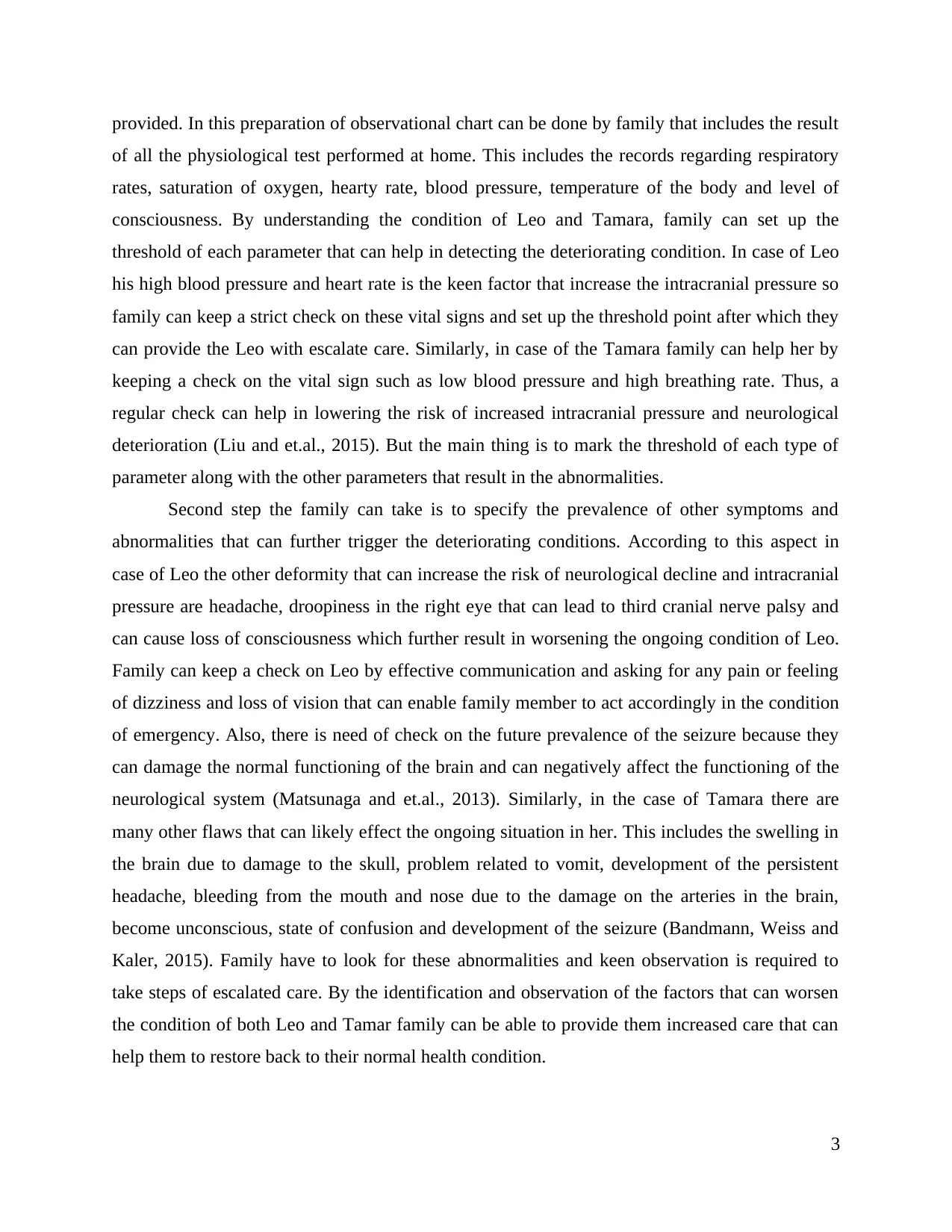
provided. In this preparation of observational chart can be done by family that includes the result
of all the physiological test performed at home. This includes the records regarding respiratory
rates, saturation of oxygen, hearty rate, blood pressure, temperature of the body and level of
consciousness. By understanding the condition of Leo and Tamara, family can set up the
threshold of each parameter that can help in detecting the deteriorating condition. In case of Leo
his high blood pressure and heart rate is the keen factor that increase the intracranial pressure so
family can keep a strict check on these vital signs and set up the threshold point after which they
can provide the Leo with escalate care. Similarly, in case of the Tamara family can help her by
keeping a check on the vital sign such as low blood pressure and high breathing rate. Thus, a
regular check can help in lowering the risk of increased intracranial pressure and neurological
deterioration (Liu and et.al., 2015). But the main thing is to mark the threshold of each type of
parameter along with the other parameters that result in the abnormalities.
Second step the family can take is to specify the prevalence of other symptoms and
abnormalities that can further trigger the deteriorating conditions. According to this aspect in
case of Leo the other deformity that can increase the risk of neurological decline and intracranial
pressure are headache, droopiness in the right eye that can lead to third cranial nerve palsy and
can cause loss of consciousness which further result in worsening the ongoing condition of Leo.
Family can keep a check on Leo by effective communication and asking for any pain or feeling
of dizziness and loss of vision that can enable family member to act accordingly in the condition
of emergency. Also, there is need of check on the future prevalence of the seizure because they
can damage the normal functioning of the brain and can negatively affect the functioning of the
neurological system (Matsunaga and et.al., 2013). Similarly, in the case of Tamara there are
many other flaws that can likely effect the ongoing situation in her. This includes the swelling in
the brain due to damage to the skull, problem related to vomit, development of the persistent
headache, bleeding from the mouth and nose due to the damage on the arteries in the brain,
become unconscious, state of confusion and development of the seizure (Bandmann, Weiss and
Kaler, 2015). Family have to look for these abnormalities and keen observation is required to
take steps of escalated care. By the identification and observation of the factors that can worsen
the condition of both Leo and Tamar family can be able to provide them increased care that can
help them to restore back to their normal health condition.
3
of all the physiological test performed at home. This includes the records regarding respiratory
rates, saturation of oxygen, hearty rate, blood pressure, temperature of the body and level of
consciousness. By understanding the condition of Leo and Tamara, family can set up the
threshold of each parameter that can help in detecting the deteriorating condition. In case of Leo
his high blood pressure and heart rate is the keen factor that increase the intracranial pressure so
family can keep a strict check on these vital signs and set up the threshold point after which they
can provide the Leo with escalate care. Similarly, in case of the Tamara family can help her by
keeping a check on the vital sign such as low blood pressure and high breathing rate. Thus, a
regular check can help in lowering the risk of increased intracranial pressure and neurological
deterioration (Liu and et.al., 2015). But the main thing is to mark the threshold of each type of
parameter along with the other parameters that result in the abnormalities.
Second step the family can take is to specify the prevalence of other symptoms and
abnormalities that can further trigger the deteriorating conditions. According to this aspect in
case of Leo the other deformity that can increase the risk of neurological decline and intracranial
pressure are headache, droopiness in the right eye that can lead to third cranial nerve palsy and
can cause loss of consciousness which further result in worsening the ongoing condition of Leo.
Family can keep a check on Leo by effective communication and asking for any pain or feeling
of dizziness and loss of vision that can enable family member to act accordingly in the condition
of emergency. Also, there is need of check on the future prevalence of the seizure because they
can damage the normal functioning of the brain and can negatively affect the functioning of the
neurological system (Matsunaga and et.al., 2013). Similarly, in the case of Tamara there are
many other flaws that can likely effect the ongoing situation in her. This includes the swelling in
the brain due to damage to the skull, problem related to vomit, development of the persistent
headache, bleeding from the mouth and nose due to the damage on the arteries in the brain,
become unconscious, state of confusion and development of the seizure (Bandmann, Weiss and
Kaler, 2015). Family have to look for these abnormalities and keen observation is required to
take steps of escalated care. By the identification and observation of the factors that can worsen
the condition of both Leo and Tamar family can be able to provide them increased care that can
help them to restore back to their normal health condition.
3

There is need for the families to keep the record of all actions that were taken against the
deteriorating condition and audit the complete set of observation that were identified to
determine the fulfilment of the monitored plan for the effective treatment of the patients at home
(Honeybul and et.al., 2013). Thus, this method of preparing a monitoring plan the for the
identifies observational criteria (National Safety and Quality Health Service Standards, 2012).
And on the basis of these actions taken were to resolve the deteriorating condition can help
family of both Leo and Tamara to providing the Escalated care at home.
As per the views of Soize and et.al., (2014) the second approach that help family in the
identification of the deterioration and escalation of care is the development of escalate care
mechanism and call for the emergency assistance when condition of patient is deteriorating at
high level. In case of the deteriorating condition of Leo and Tamara their family can provide
them with therapies that can lower down the impact of the intracranial pressure. These therapies
can be drug therapies or normal physical therapies. In case of Leo his increased systolic blood
pressure can severely worsen the condition than he can be provided with drug therapy in which
medicines that can normalise the blood pressure can be used to decrease the lower its impact on
the body. Similarly, in the case of Tamara family can provide with drugs that can help in
controlling the increased breathing rates and decrease in blood pressure and lower down the rise
in situation that can lead to neurological disorders.
But there are certain conditions in which the family is not able to cope up with situation
than they can call foe the doctors and seek for the emergency assistance. This help in controlling
the condition of patients till they are taken to the hospitals. In many cases the severe increase in
the intracranial pressure and some deformities in neurological system can result in permanent
loss of consciousness and death (Gelb and et.al., 2013). Thus, with the help of these emergency
assistance and escalated care approach family member can encourage and help the patients to
cop up the situation till they are diagnosed in the emergency centre (Aitken, Marshall and
Chaboyer, 2016). After reaching the hospital they can be provided with advanced life support
technique in order to recover the patients in normal condition. In this way family play an
important role in recognition of the deteriorating condition and providing escalation care to their
family member.
4
deteriorating condition and audit the complete set of observation that were identified to
determine the fulfilment of the monitored plan for the effective treatment of the patients at home
(Honeybul and et.al., 2013). Thus, this method of preparing a monitoring plan the for the
identifies observational criteria (National Safety and Quality Health Service Standards, 2012).
And on the basis of these actions taken were to resolve the deteriorating condition can help
family of both Leo and Tamara to providing the Escalated care at home.
As per the views of Soize and et.al., (2014) the second approach that help family in the
identification of the deterioration and escalation of care is the development of escalate care
mechanism and call for the emergency assistance when condition of patient is deteriorating at
high level. In case of the deteriorating condition of Leo and Tamara their family can provide
them with therapies that can lower down the impact of the intracranial pressure. These therapies
can be drug therapies or normal physical therapies. In case of Leo his increased systolic blood
pressure can severely worsen the condition than he can be provided with drug therapy in which
medicines that can normalise the blood pressure can be used to decrease the lower its impact on
the body. Similarly, in the case of Tamara family can provide with drugs that can help in
controlling the increased breathing rates and decrease in blood pressure and lower down the rise
in situation that can lead to neurological disorders.
But there are certain conditions in which the family is not able to cope up with situation
than they can call foe the doctors and seek for the emergency assistance. This help in controlling
the condition of patients till they are taken to the hospitals. In many cases the severe increase in
the intracranial pressure and some deformities in neurological system can result in permanent
loss of consciousness and death (Gelb and et.al., 2013). Thus, with the help of these emergency
assistance and escalated care approach family member can encourage and help the patients to
cop up the situation till they are diagnosed in the emergency centre (Aitken, Marshall and
Chaboyer, 2016). After reaching the hospital they can be provided with advanced life support
technique in order to recover the patients in normal condition. In this way family play an
important role in recognition of the deteriorating condition and providing escalation care to their
family member.
4
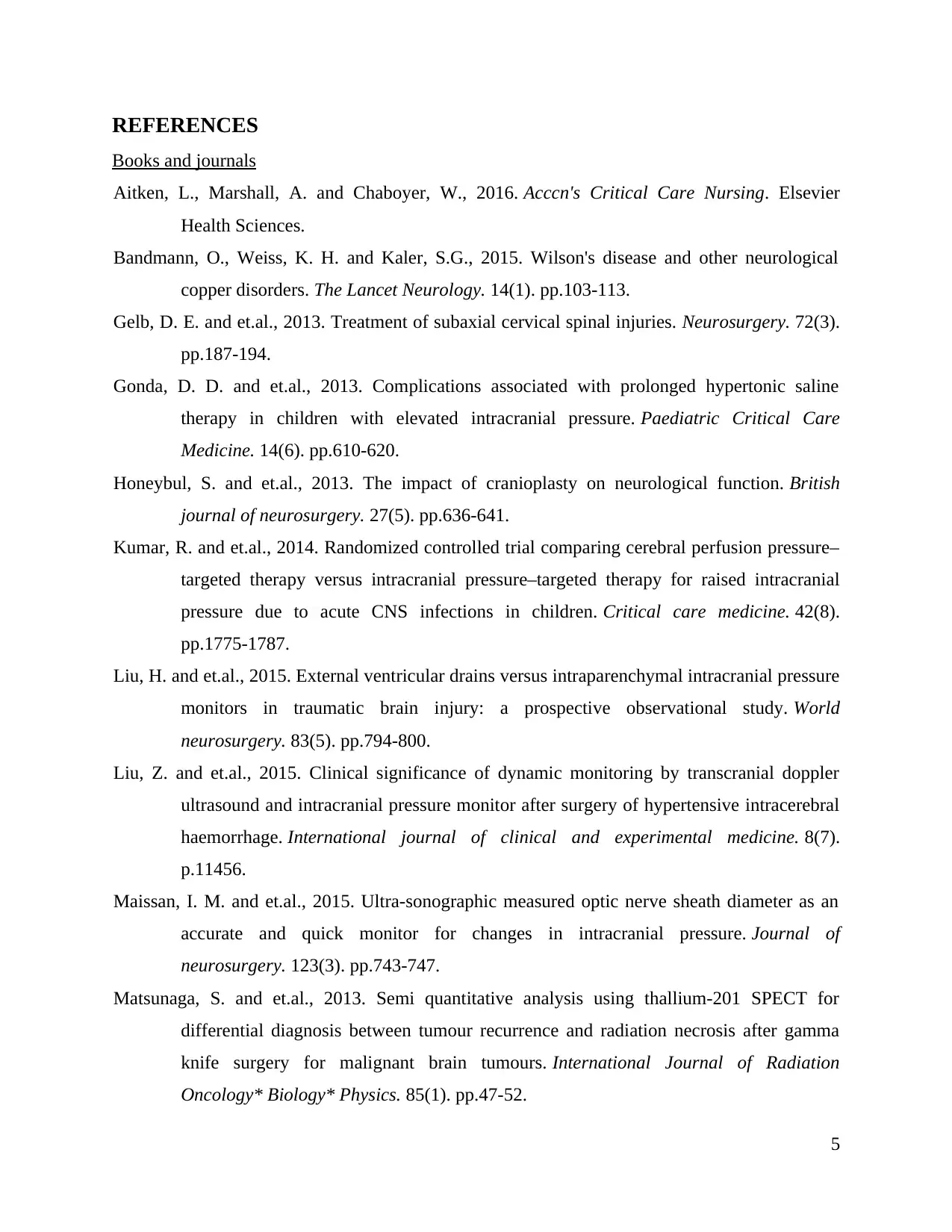
REFERENCES
Books and journals
Aitken, L., Marshall, A. and Chaboyer, W., 2016. Acccn's Critical Care Nursing. Elsevier
Health Sciences.
Bandmann, O., Weiss, K. H. and Kaler, S.G., 2015. Wilson's disease and other neurological
copper disorders. The Lancet Neurology. 14(1). pp.103-113.
Gelb, D. E. and et.al., 2013. Treatment of subaxial cervical spinal injuries. Neurosurgery. 72(3).
pp.187-194.
Gonda, D. D. and et.al., 2013. Complications associated with prolonged hypertonic saline
therapy in children with elevated intracranial pressure. Paediatric Critical Care
Medicine. 14(6). pp.610-620.
Honeybul, S. and et.al., 2013. The impact of cranioplasty on neurological function. British
journal of neurosurgery. 27(5). pp.636-641.
Kumar, R. and et.al., 2014. Randomized controlled trial comparing cerebral perfusion pressure–
targeted therapy versus intracranial pressure–targeted therapy for raised intracranial
pressure due to acute CNS infections in children. Critical care medicine. 42(8).
pp.1775-1787.
Liu, H. and et.al., 2015. External ventricular drains versus intraparenchymal intracranial pressure
monitors in traumatic brain injury: a prospective observational study. World
neurosurgery. 83(5). pp.794-800.
Liu, Z. and et.al., 2015. Clinical significance of dynamic monitoring by transcranial doppler
ultrasound and intracranial pressure monitor after surgery of hypertensive intracerebral
haemorrhage. International journal of clinical and experimental medicine. 8(7).
p.11456.
Maissan, I. M. and et.al., 2015. Ultra-sonographic measured optic nerve sheath diameter as an
accurate and quick monitor for changes in intracranial pressure. Journal of
neurosurgery. 123(3). pp.743-747.
Matsunaga, S. and et.al., 2013. Semi quantitative analysis using thallium-201 SPECT for
differential diagnosis between tumour recurrence and radiation necrosis after gamma
knife surgery for malignant brain tumours. International Journal of Radiation
Oncology* Biology* Physics. 85(1). pp.47-52.
5
Books and journals
Aitken, L., Marshall, A. and Chaboyer, W., 2016. Acccn's Critical Care Nursing. Elsevier
Health Sciences.
Bandmann, O., Weiss, K. H. and Kaler, S.G., 2015. Wilson's disease and other neurological
copper disorders. The Lancet Neurology. 14(1). pp.103-113.
Gelb, D. E. and et.al., 2013. Treatment of subaxial cervical spinal injuries. Neurosurgery. 72(3).
pp.187-194.
Gonda, D. D. and et.al., 2013. Complications associated with prolonged hypertonic saline
therapy in children with elevated intracranial pressure. Paediatric Critical Care
Medicine. 14(6). pp.610-620.
Honeybul, S. and et.al., 2013. The impact of cranioplasty on neurological function. British
journal of neurosurgery. 27(5). pp.636-641.
Kumar, R. and et.al., 2014. Randomized controlled trial comparing cerebral perfusion pressure–
targeted therapy versus intracranial pressure–targeted therapy for raised intracranial
pressure due to acute CNS infections in children. Critical care medicine. 42(8).
pp.1775-1787.
Liu, H. and et.al., 2015. External ventricular drains versus intraparenchymal intracranial pressure
monitors in traumatic brain injury: a prospective observational study. World
neurosurgery. 83(5). pp.794-800.
Liu, Z. and et.al., 2015. Clinical significance of dynamic monitoring by transcranial doppler
ultrasound and intracranial pressure monitor after surgery of hypertensive intracerebral
haemorrhage. International journal of clinical and experimental medicine. 8(7).
p.11456.
Maissan, I. M. and et.al., 2015. Ultra-sonographic measured optic nerve sheath diameter as an
accurate and quick monitor for changes in intracranial pressure. Journal of
neurosurgery. 123(3). pp.743-747.
Matsunaga, S. and et.al., 2013. Semi quantitative analysis using thallium-201 SPECT for
differential diagnosis between tumour recurrence and radiation necrosis after gamma
knife surgery for malignant brain tumours. International Journal of Radiation
Oncology* Biology* Physics. 85(1). pp.47-52.
5
Paraphrase This Document
Need a fresh take? Get an instant paraphrase of this document with our AI Paraphraser
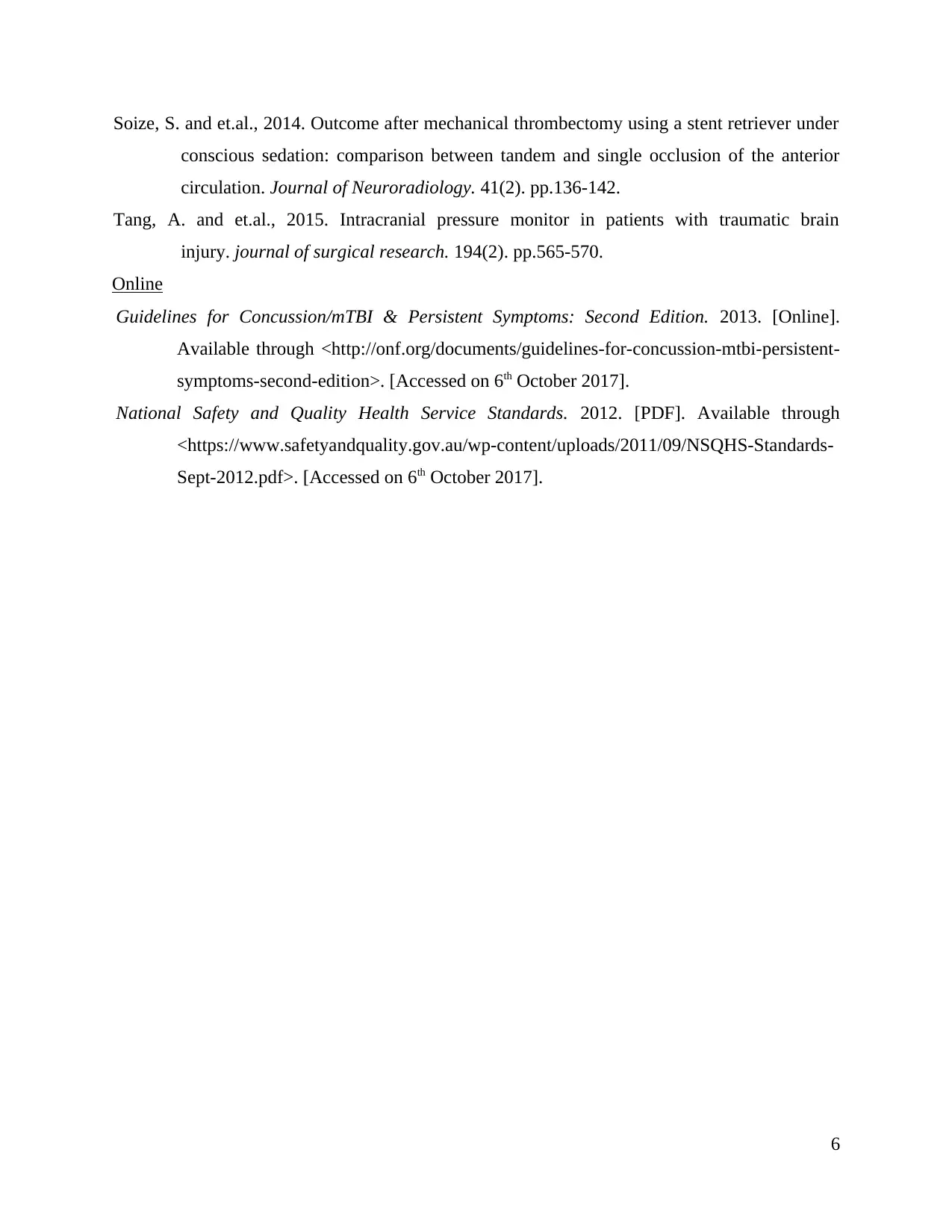
Soize, S. and et.al., 2014. Outcome after mechanical thrombectomy using a stent retriever under
conscious sedation: comparison between tandem and single occlusion of the anterior
circulation. Journal of Neuroradiology. 41(2). pp.136-142.
Tang, A. and et.al., 2015. Intracranial pressure monitor in patients with traumatic brain
injury. journal of surgical research. 194(2). pp.565-570.
Online
Guidelines for Concussion/mTBI & Persistent Symptoms: Second Edition. 2013. [Online].
Available through <http://onf.org/documents/guidelines-for-concussion-mtbi-persistent-
symptoms-second-edition>. [Accessed on 6th October 2017].
National Safety and Quality Health Service Standards. 2012. [PDF]. Available through
<https://www.safetyandquality.gov.au/wp-content/uploads/2011/09/NSQHS-Standards-
Sept-2012.pdf>. [Accessed on 6th October 2017].
6
conscious sedation: comparison between tandem and single occlusion of the anterior
circulation. Journal of Neuroradiology. 41(2). pp.136-142.
Tang, A. and et.al., 2015. Intracranial pressure monitor in patients with traumatic brain
injury. journal of surgical research. 194(2). pp.565-570.
Online
Guidelines for Concussion/mTBI & Persistent Symptoms: Second Edition. 2013. [Online].
Available through <http://onf.org/documents/guidelines-for-concussion-mtbi-persistent-
symptoms-second-edition>. [Accessed on 6th October 2017].
National Safety and Quality Health Service Standards. 2012. [PDF]. Available through
<https://www.safetyandquality.gov.au/wp-content/uploads/2011/09/NSQHS-Standards-
Sept-2012.pdf>. [Accessed on 6th October 2017].
6
1 out of 8
Related Documents
Your All-in-One AI-Powered Toolkit for Academic Success.
+13062052269
info@desklib.com
Available 24*7 on WhatsApp / Email
![[object Object]](/_next/static/media/star-bottom.7253800d.svg)
Unlock your academic potential
© 2024 | Zucol Services PVT LTD | All rights reserved.




